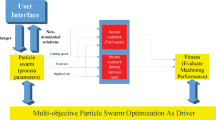Abstract
This paper presents a particle swarm optimization (PSO) technique to train an artificial neural network (ANN) for prediction of flank wear in drilling, and compares the network performance with that of the back propagation neural network (BPNN). This analysis is carried out following a series of experiments employing high speed steel (HSS) drills for drilling on mild steel workpieces, under different sets of cutting conditions and noting the root mean square (RMS) value of spindle motor current as well as the average flank wear in each case. The results show that the PSO trained ANN not only gives better prediction results and reduced computational times compared to the BPNN, it is also a more robust model, being free of getting trapped in local optimum solutions unlike the latter. Besides, it offers the advantages of a straight-forward logic, simple realization and underlying intelligence.








Similar content being viewed by others
References
Asokan P, Baskar N, Babu K, Prabhaharan G and Saravanan R 2005 Optimization of surface grinding operations using particle swarm optimization technique. J. Manufacturing Sci. Eng. 127: 885–892
Clerc M 1999 The swarm and the queen: towards a deterministic and adaptive particle swarm optimization. Proceedings of Congress on Evolutionary Computation, Washington DC, pp. 1951–1957
Eberhart R C and Kennedy J 1995 A new optimizer using particle swarm theory. Proceedings of the Sixth International Symposium on Micro Machine and Human Science, Nagoya: Japan, pp. 39–43
Elbeltagi E, Hegazy T and Grierson D 2005 Comparison among five evolutionary-based optimization algorithms. Advanced Eng. Informatics 19: 43–53
Fausett L 1994 Fundamentals of Neural Networks, Engle-wood Cliffs, NJ: Prentice-Hall
Feng H M 2006 Self-generation RBFNs using evolutional PSO learning. Neurocomputing 70: 241–251
Gaitonde V N and Karnik S R 2012 Minimizing burr size in drilling using artificial neural network (ANN)-particle swarm optimization (PSO) approach. J. Intelligent Manufacturing J. Intelligent Manufacturing 23: 1783–1793
Haq A N, Sivakumar K, Saravanan R and Karthikeyan K 2006 Particle swarm optimization (PSO) algorithm for optimal machining allocation of clutch assembly. Int. J. Advance Manufacturing Technol. 27: 865–869
Jantunen E 2002 A summary of methods applied to tool condition monitoring in drilling. Int. J. Machine Tools and Manufacture 42: 997–1010
Kanai M, Inata K, Fujii S and Kanda Y 1978 Statistical characteristics of drill wear and drill life for the standardized performance tests. Annals of CIRP 27(1): 61–66
Karpat Y and Ozel T 2005 Hard turning optimization using neural network modelling and swarm intelligence. Transactions of NAMRI/SME 33: 179–186
Kennedy J and Eberhart R 1995 Particle swarm optimization. Proceedings of the IEEE international conference on neural networks, Perth, Australia, Piscataway NJ: IEEE Service Center, pp. 1942–1948
Malviya R and Pratihar D K 2011 Tuning of neural networks using particle swarm optimization to model MIG welding process. Swarm and Evolutionary Computation 1: 223–235
Navalertporn T and Afzulpurkar N V 2011 Optimization of tile manufacturing process using particle swarm optimization. Swarm and Evolutionary Computation 1: 97–109
Patra K, Pal S K and Bhattacharyya K 2007 Artificial neural network based prediction of drill flank wear from motor current signals. Appl. Soft Comput., 7: 929–935
Samanta B and Nataraj C 2009 Use of particle swarm optimization for machinery fault detection. Eng. Appl. Artificial Intelligence, 22: 308–316
Shaw M C 1992 Metal cutting principles. PCBS Publishers & Distributors, 1st Indian edition, ISBN 81-239-0136-4, pp. 224–250
Shi Y and Eberhart R 1998 A modified particle swarm optimizer. Proceedings of the IEEE international conference on evolutionary computation, Piscataway, NJ: IEEE Press; pp. 69–73
Shi Y and Eberhart R 2000 Experimental study of particle swarm optimization. Proceedings of SCI 2000 Conference, Orlando: FL
Stacey A, Jancic M and Grundy I 2003 Particle swarm optimization with mutation. Proceedings of IEEE, pp. 1425–1430
Zhang C and Shao H 2000 An ANN’s evolved by a new evolutionary System and its application. Proceedings of the 39th IEEE Conference on Decision and Control, Sydney, Australia, pp. 3562–3563
Zhao F, Ren Z, Yu D and Yang Y 2005 Application of an improved particle swarm optimization algorithm for neural network training. Proceedings of IEEE International Conference on Neural Networks and Brain, Beijing, China, pp. 1693–1698
Zhou J, Duan Z, Li Y, Deng J and Yu D 2006 PSO-based neural network optimization and its utilization in a boring machine. J. Material Process Technol. 178: 19–23
Author information
Authors and Affiliations
Corresponding author
Rights and permissions
About this article
Cite this article
GARG, S., PATRA, K. & PAL, S.K. Particle swarm optimization of a neural network model in a machining process. Sadhana 39, 533–548 (2014). https://doi.org/10.1007/s12046-014-0244-7
Received:
Revised:
Accepted:
Published:
Issue Date:
DOI: https://doi.org/10.1007/s12046-014-0244-7




